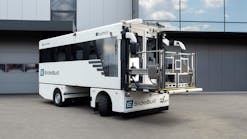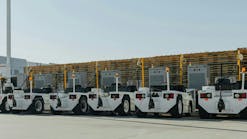Port Authority Embarks on Bold Plan to Slash Pollution to Zero by 2050
Port Authority officials announced a far-reaching greenhouse gas reduction plan Tuesday to make its facilities “net zero” by 2050, and said it will meet one goal early, replacing its light duty vehicle fleet with electrics two years ahead of schedule.
Officials of the bi-state authority announced their blueprint Tuesday to reduce greenhouse gases to zero in front of the historic “Building One” — the first building constructed at Newark Liberty airport. That administration building will be the prototype for reducing and eliminating the carbon footprint of all the agency’s buildings, as part of a broader 12-part roadmap to zero carbon emissions by mid-century.
“The agency has achieved multiple early milestones on the road we set out,” said Rick Cotton, authority executive director. “They are demonstrations of our commitment to make this road map a plan of action in which we deliver accomplishments and achievements in the real world and not just on paper.”
The so-called “NetZero” blueprint builds on an earlier plan announced by Cotton in 2017 when the authority said it would adhere to the Paris Climate Change accords. The authority used a base level from 2006 when 274,000 tons of Carbon Dioxide was being emitted from authority “assets” and set goals to reduce emissions by 35% by 2025 and 50% by 2030, said Kevin O’Toole, authority board of commissioner chairman.
“We’re well on way to hit markers of a 25% and 35% reduction, whether it is electrification, solar, wind, green leases or working with our partners. It’s a big master plan and it will take a lot of work,” he said.
The NetZero plan is estimated to cost “several hundred of millions of dollars” over the three decades it spans, Cotton said. It also aligns with national and state climate change goals set by the Biden and Murphy administrations to move to 100% “clean” energy by 2050.
Hurricane Sandy caused $2.5 billion in damage to Port Authority facilities in October 2012, primarily flood damage to the PATH rail systems, World Trade Center and at JFK, Newark and LaGuardia airports, authority officials said on the tenth anniversary of the storm.
“What’s the cost if we don’t do it in climate change damage?” O’Toole asked.
After it was unveiled, the plan was praised by Preethy Thangarj, director of Gov. Phil Murphy’s office of energy and sustainability.
“The Port Authority is leading by example,” she said.
In a statement, Murphy said “the Port Authority will continue to help advance the Garden State’s pursuit of a 100 percent clean-energy economy by 2035. This determined pursuit is especially urgent to safeguard our environmental justice communities from the intensifying impacts of the climate crisis.”
The first part of the plan is to continue electrification of the authority’s 2,500 light, medium, and heavy-duty vehicles and build the necessary charging infrastructure of at least 600 charging stations, 375 of which are in service. The agency has already purchased a 32-foot all electric Kenworth truck.
In addition to its own vehicles, the authority has worked with airlines at its three airports to replace aviation ground support equipment with 1,000 pieces of electric equipment. An electric aircraft “tug” and an electric baggage conveyor from United Airlines were on display at the press event.
Ultimately, the plan calls for third-parties to use zero-emission vehicles that are stationed at and travel to and from the airports and the support airlines transitioning to zero-emission aircraft and sustainable aviation fuel, and to reduce emissions from aircraft operations.
The authority now has the largest electric bus fleet of any airport at 46 buses, and has replaced 89 of 91 ship to shore and rail gantry cranes in the port with electric powered cranes that lift containers between trucks, ships and trains, Cotton said.
Plans for the Building One prototype call for replacing boilers with electric heat pumps, replacing conventional lighting with LEDs that consume less energy, installing solar panels on the roof and on canopies over parking lots, said Chris Diamond, authority sustainability director.
“We’ll start with making it as efficient as possible,” he said.
Building One will be fully “decarbonized” in 2025 and will serve as the model for other low rise buildings at the authority’s facilities in New Jersey and New York. The authority’s central plants, that provide energy for heating and cooling for buildings properties, also would transition to resilient, net zero emission systems, under the plan.
The plan outlines 40 steps, includes electrifying the heavy duty vehicle fleet, ensuring purchased energy from the electric power grid is “green” produced, requiring new buildings constructed are built to the latest sustainability and energy efficiency standards.
The authority got a jump on solar earlier this year, opening the largest solar powered airport building in the nation, a consolidated parking garage and rental car center adjacent to the new Terminal A at Newark Airport, which joins solar arrays built at LaGuardia airport.
The Port Authority is planning to build a larger solar canopy that will be three times the size of the Terminal A parking deck at JFK airport that will power the AirTrain system that serves that airport. That canopy also will provide electricity on a subscription basis for up to 6,000 residents in the adjacent Queens community who wouldn’t have access to solar power.
Port Authority officials said they’re aware of the difficulty of such a sweeping transition.
“We’re under no illusion it will be easy, but it’s necessary,” Diamond said.
Please subscribe now and support the local journalism YOU rely on and trust.
Larry Higgs may be reached at [email protected].
©2023 Advance Local Media LLC. Visit nj.com. Distributed by Tribune Content Agency, LLC.





